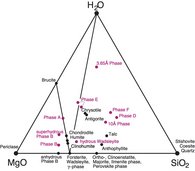Experimental studies have shown that a number of dense hydrous silicates are stable at mantle pressures, corresponding to depths greater than 200 km: e.g. phase A, phase B, phase E, superhydrous phase B, phase Egg. If present in the Earth’s mantle these minerals are important hosts for H2O and their dehydration at much higher P and T may be responsible for deep focus earthquakes. To understand the Earth’s water cycle it is important to learn more about their stabilities and phase relations at P and T (e. g., dehydration reactions).
Fig.: Selected phases in the system MgO-SiO2-H2O. Coloured are Dense Hydrous Magnesium Silicates (DHMS) of which only 10Å phase has been found in nature yet. Some confusion exists concerning nomenclature and identification (superhydrous phase B = phase C; phase D = phase F and phase G)
Contact
Prof. Dr. Monika Koch-Müller
Dr. Christian Lathe
Dr. Xinyang Li
Dr. Sergio Speziale
Dr. Bernd Wunder
Partner
Mainak Mookherjee, Florida State University, Tallahassee
Mark David Welch, The Natural History Museum, London
Dr. Hanns-Peter Liermann, Deutsches Elektronen-Synchrotron DESY, Hamburg


